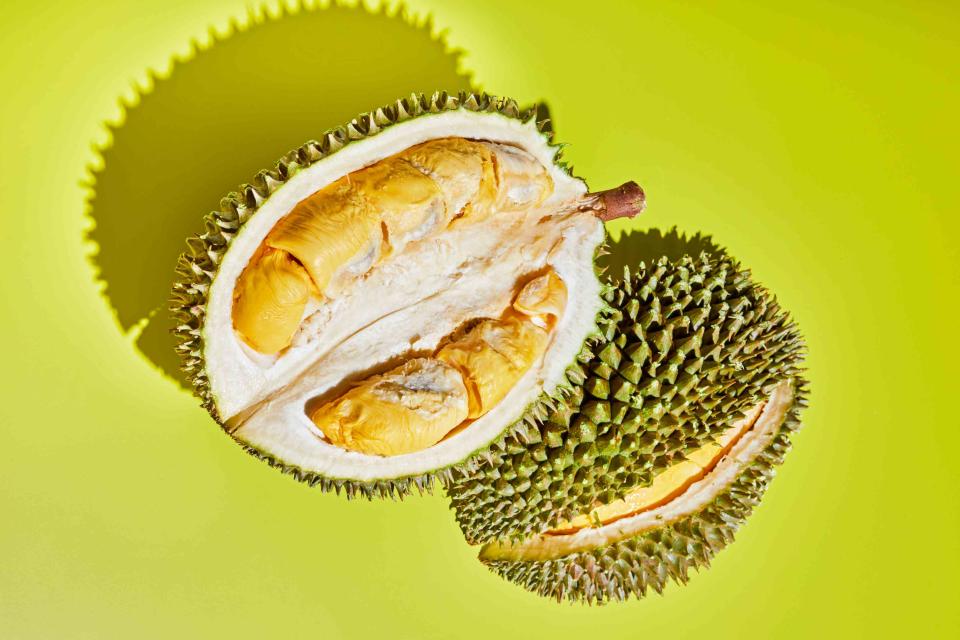This Writer Travels the World in Search of a Single Fruit
How Lindsay Gasik's year of the durian became a decade.

Jason Donnelly / Food Styling by Lauren McAnelly / Prop Styling by Lexi Juhl
Dry season never comes for Lindsay Gasik and her husband, Richard Koivusalo. For the past decade, they have been leading durian-centric tours across the planet and documenting their travels on Instagram. The couple travels around the world according to monsoon seasons, the rainy periods that allow durians to ripen. They land in a country as the season comes to an end, just in time to taste the enormous, spiky fruit at its peak. Sometimes their destination is a well-known durian-growing area, like Thailand or the Philippines — other times, Zanzibar or Hawaii. To learn more or to book a durian tour, visit yearofthedurian.com.
NT: How does the durian focus change how you travel?
Lindsay Gasik: You end up going to places you never knew even existed, because it's not on Lonely Planet or the main highlight reels. People are overwhelmingly friendly because you’re interested in their life. There’s always someone like, “Oh, my uncle has a durian farm; get on the back of my motorbike, let’s go.” It’s instantly like we’ve been buddies for 10 years.
Related: 30 Summer Fruit Recipes We Love
NT: What keeps durian exciting?
LG: The clues. We’re detectives, and there are different stories that we’re on the hunt for. Durians all have a story behind them: where they came from, which tree was where. The trees can live for hundreds of years, so when we're looking for the story behind them, we're almost looking for mythology. For example, Musang King is now the ubiquitous durian [in Malaysia]. It's like 90% of exports, but it comes from a tree that died. I haven't figured out exactly when it died — that's one of the things I'm looking for. Everyone says in the records it was 1790.
These trees are old, and there’s been lots of empire shifting: colonial powers, different kings and sultans — all this political drama going on — while in the background, the trees were just chilling, having time pass, and when you try to go back and find these stories of like, where Musang King came from, you end up finding all these amazing stories of real people who existed, and it helps you understand how a place developed.
We're not only looking at the tree, but we're also considering the soil, the area, the clay, and different fertilizers and how they affect the root systems. All these very systematic things, like what makes a tree healthy versus not healthy, or a fruit taste good. You can ultimately change your fruit by changing its fertilizers. I’m a history nerd, so I do all this research and dig through archives and try to figure all this stuff out. I found records on a tree from 1890 and wondered what was there now. Then we showed up and I was like, “Oh, my God, it’s still here.”
NT: What do you love about durian?
LG: There’s a lot of craftsmanship that goes into durian. You can control a lot of things about it. Beyond genetics, people can control the flavor through pre-harvest and post-harvest practices. For example, in Malaysia, durians are all tree-fallen and eaten within a few hours of dropping, when the flesh is fully soft but still sticky and smooth. In Indonesia, people allow the durian to fall but then purposefully wait 24 hours or more for it to ferment into a yogurty texture that is sweet, but it also can have acidic flavors like pineapple or berry, with a strong aftertaste. I’ve heard people say that durian tastes like onion, when what they’re experiencing is a spicy note — something with a bite. It’s hard for some people to understand how many iterations of durian there are because people just think of a fruit. But think about apples: You have everything from Granny Smith to those fancy pink dessert apples. There’s a big variation among durians, and when they taste the right one, they love it.
For more Food & Wine news, make sure to sign up for our newsletter!
Read the original article on Food & Wine.

